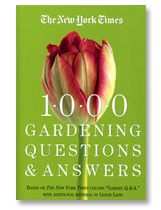seasonal alerts
Spring forward; fall back, say phooey to the whole probably doesn’t save energy thing. Gardeners always know what’s what, daylight-wise, and no amount of fiddling with the clock can make any more of it.
We’re already hardwired to natural seasons. Winter – finally! – is for taking a break, though it’s work to resist catalogs in which every flower is blemish-free and every fruit delicious. Spring is for doing the monster sprint: move the stuff that wasn’t divided last fall, plant and plant, weed and weed and prune and pinch andthenthenextthingyou know, it’s harvest. Roast the summer tomatoes; freeze the succotash; move the tender plants indoors and get ready to get your jollies from things that grow in pots.
Only one problem: Whether you have the above hot-cold version, the western dry-wet or the tropical wet and more wet, seasons appear to be headed toward Hades in a globally warmed handbasket. Familiar rituals need adjustment.
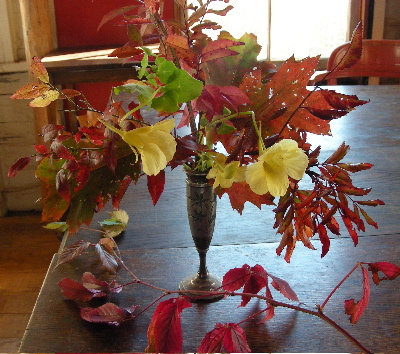
What’s wrong with this picture ( other than the fact that real autumn leaves, having been hard at work all summer, don’t look as though they’ve had work done)?
Until this year, our record late date for nasturtium killing frost was October 6th, two days later than the previous record. This year, it was the 28th. Authorities quibble about how much longer the northern growing season lasts, but nobody has any trouble tacking a week or more on each end. And nobody ( unless you count the USDA) has any trouble seeing that most northern climate zones should have higher numbers than they did a decade ago.
Coping: Don’t assume this means you’ve been promoted. Zones measure only the lowest average winter low. That means little if there is also a 6 week warm spell that starts in mid-February and plunges to a frigid end after persuading your peach trees to start blooming. In the north, planting fruit trees on north-facing slopes is more important than ever. In the south, remember the zone range has a high end as well as a low one. Cold-loving plants like sugar maples and rhododendrons are now an unwise bet at the hotter end of their range.

Warmer weather means earlier leaf-out for many trees. That means spring ephemerals like this bloodroot – and crocus, narcissus and bluebells – may not get as much sun as they need to come back strongly year after year.
Coping: plant spring bulbs closer to tree’s drip lines, or out in the open. Consider limbing up – winter is a great time to look at the shapes of deciduous trees and think sculptural thoughts.
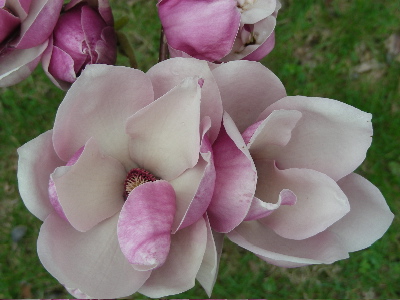
This Magnolia soulangeana was planted by an optimist, probably about 50 years ago, and was already huge when we bought the Hudson Valley house. In the old days, it was like Charlie Brown and the football, blossoms would start to unfold, a pink cloud on the horizon and then BAM! browned by frost, year after year. Not any more.
Coping: Fine to plant trees that were once marginal but do bear in mind that fruit-free male trees aren’t problem free. They don’t bear messy or smelly fruits, but they do add to the pollen burden, and allergy sufferers are already going to take a hit: increased carbon dioxide does great things for ragweed as well as poison ivy.
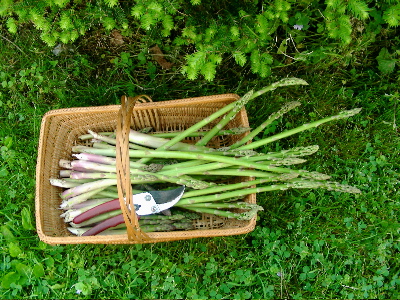
(The pruner is there to show how long the spears are; they were cut in the standard way: with a knife, under ground, to deny any passing beetles a place to land.)
Bill grew up knowing that “if the patch is strong, you can cut asparagus until the 4th of July.” Not true when you start cutting 2 or 3 weeks earlier than formerly. Going by the calendar instead of the size of the spears was never a completely wise idea, but now it would be a recipe for greatly diminished production if not outright death.
Coping: Stop cutting when new shoots start being thinner and fewer. Warm winters mean more asparagus beetles ( as well as every other wretched bug I can think of at the moment). Be sure to clean away old stalks and all surrounding debris; that’s where the eggs winter over.
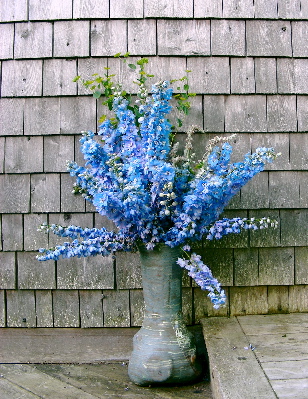
What’s wrong with THIS picture? We don’t have that all many delphiniums. The bouquet is a consequence of a brutal rainstorm.
Coping: Delphiniums are famous for this, regardless of climate doings, but there’s no question summer storms are becoming stronger. Think carefully before planting things that are vulnerable to wind. Fertilize modestly; encouraging plants to be as tall as possible is no longer a good idea unless you’re fond of the staked-up look.
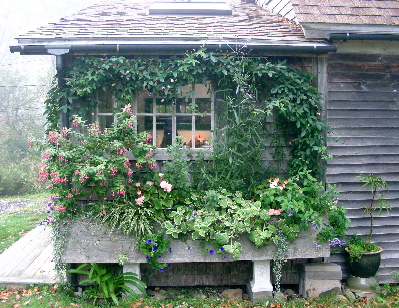
Storms are also a problem for brittle plants like tender fuchsias. The one on the left is inconspicuously anchored to the wall so strong winds won’t bust it.

This eye-catching fall display is pure genius on the part of the farmer. Not only does it announce abundance to passers-by on the busy highway, it’s also easy to cover on cold nights. Winter squash that is blemished by frost won’t keep. The grand assortment of squash that’s available at farmstands right now won’t keep either, btw; be sure to buy soon and store at home for the best flavor assortment.

It’s tempting to leave houseplants out as long as possible, especially when they’re protected by being close to the house. But if you plan to enjoy them indoors they need time to get adjusted to low light and dry air. Bringing them in when it’s still warm and bright enough to put them in an unheated sunroom or other transitional space will increase the chances that they stay strong, for when you need them most.

outside

inside. Our friend from the window box. Passionflowers are particularly willing to do the in- and – out dance. Logee’s and Brushwood Nursery are among the many sellers with tempting assortments.

Daylight saving thought to live by: Every roasted or dried or frozen tomato you put by is saved daylight; as is every flower on winter’s amaryllis, there because the bulb was nourished by sun on last summer’s leaves.
It’s not puddle-wonderful yet; but we’re gainin.’ About a third of the crocus are up; almost all of the snow is gone and Bill is starting to make fly-casting gestures as we walk over the hill to the broad meadow threaded by Sprout Creek.
And once we’re there the creekside trees are filled with red-winged blackbirds, the birds that mean spring to me. Never mind the robins; they’re around all winter now, and though geese on the move are still distantly evocative, the reality of geese on the ground is too painful for them to have much spring cred left.
The forecast is for April showers all week – until Thursday, when snow is predicted. Doesn’t matter, the red-winged blackbirds are here, trilling and burbling and rasping over the water. Better days are coming.

Red-wings do sometimes come to the feeder, but Mr. Earl is actually looking at a house finch. It’s clinging to a native wisteria (W. frutescens) that will eventually – we hope – provide summer shade.
Blackbird tidbit from the terrific Cornell bird site: The males fight mega for territory and each usually has multiple females resident in his real estate. But the females seem to be no boundaries types: from a quarter to half of their offspring are sired by the neighbors.
Some couples disagree about when to turn on the furnace in fall, others about the proper time to ask for directions or –– if partnered, you can no doubt fill the blank. With us, it’s a long-standing difference of opinion about when to prune the rescued old fruit trees in the New York yard. Bill wants to do it in late winter, when farmers have always pruned their trees. I want it done in summer, because I know there will be more flowers, less regrowth and fewer water sprouts.
He has the weight of tradition on his side; I have nothing except being right. And as “want it done” suggests, I have ( and should have) zero say, because he’s the one who does it.

If you’re serious about summer pruning, trying to produce good fruit or a well-behaved espalier, you follow some modified form of the Lorette system, developed in the early 20th century by Louis Lorette, a professor at the Lycee Agricole in Wagnonville, France. The process is briefly described by NAFEX member Mark Lee, gone into more deeply by a publication from New Mexico State University. M. Lorette’s book itself is out of print, but there are copies – both English and French – available through Bookfinder.
The climate of the Northern US having little in common with that of the Department du Nord, modified is the operative word; you can get into trouble treating your trees as though they were in France. But assuming you’re managing mature trees, not encouraging young ones, there’s much to be said for pruning that tends to stay put.
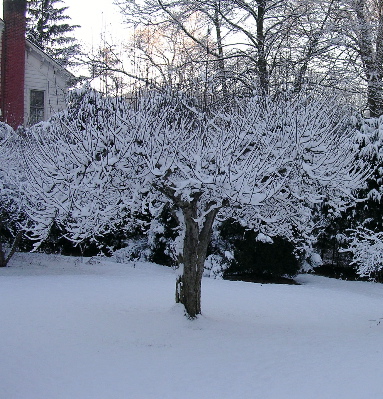
See all those useless, non-flowering water sprouts sticking straight up? That’s a present from last year’s dormant pruning. It’s not so bad on trees that have been kept in check from infancy, but it can still be a pain in the pruner.
The Argument, Short Version:
Advantages of dormant pruning:
Leafless branch structure is clear; you can see what you’re doing
Fungus diseases are dormant too, so there’s less danger of transmission
Tree is just about to start the active growth that promotes wound-healing
You are not doing the 30,000 other agricultural things that claim your time in midsummer
Advantages of summer pruning:
Vegetative growth is restricted. Tree stays smaller.
Tree does not send up a gazillion water sprouts that must in their turn be pruned.
Fruiting spurs develop closer to main branches, and there are often more of them.
It’s ( usually) more pleasant to be working outdoors
It was 4 degrees and quiet when we woke at 6:30. Now at noon it’s up to 10 and blowing like a bandit, with merry tinkling of ice pellets against the windows and the occasional loud whoosh of something that would be granita if it had flavoring.
Inside, two harbingers of spring:
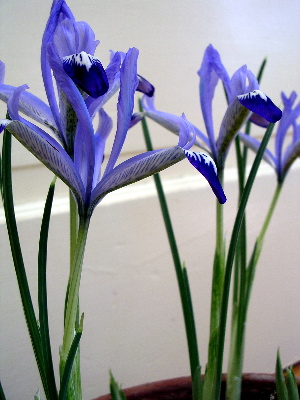
Iris reticulata is easy to force and unlike tulips, daffodils and I. versicolor (old-fashioned blue flag) it’s seldom sold by florists. This is Clairette, which is not like its picture both because it’s much more purple and because it’s much more fragrant. Catalogs seldom mention the perfume of these little charmers, but it’s definitely there and far easier to appreciate when the garden is on the tabletop.

The beans in the bag are Dr. Martin limas. !Delicious! Sweet and lima-beany and creamy, not mealy even at full huge size of over an inch wide. Didn’t used to be able to grow them in the Hudson Valley. Would cheerfully trade them for less global warming but let’s not forget the ill wind part … Seed is comparatively rare and well-worth saving; we got the original batch from Rohrer’s
Well, bringing in, anyway.

The brugmansia got cut back to the biggest stems, dug up – with attendant root pruning, as you can imagine – and replanted ( unceremoniously stuffed, actually) in a contractor-weight garbage bag. Bill then bumped it downstairs into the cellar, where it will remain until next spring.
The squash went into the living room while we try to find a storage spot that will stay between 50 and 60 degrees; winter squash rot if they get chilled. My food historian friend Sandy Oliver, editor of Food History News, whose lifestyle would not be alien to many of her subjects, recommends keeping them under the bed.
This isn’t just about preservation; most hard-shelled squash* are unready at harvest. They need about 6 weeks of aging to develop their smoothest texture and maximum sweetness.
* Everything except acorn, really: butternut, buttercup, Hubbard, you name it and especially Japanese “sweet potato” types like the knobby dark green Black Futsu in the wheelbarrow. It will turn a golden tan before it comes into its glory…
Even if you didn’t grow any winter squash, this is handy to remember, because the great array of nifty, offbeat squash at the farmers’ market will only be there until Thanksgiving. If you want to enjoy a wider, more delicious (and far more beautiful) assortment than the paltry selection at supermarkets, stock up now while the stocking’s good…
The frost is STILL not quite on the pumpkin – our few light dips below freezing have not even killed the summer squash, I’m sorry to say.
But almost.

So here are a few Garden Cleanup Tips:
* Before you start removing the evidence, make a rough map/ post mortem report that can be used for planning next year. Include relevant outside factors like deer predation – which you’d THINK you’d remember but if you’re like me you tend to have denial problems about the smaller, less painful losses.
It’s also helpful to note things like the amount of rain: lousy tomato taste, for example, may be blamed on too much water and the too little sun that implies. But that same rain is probably why the hollyhocks hit 10 feet.
* when removing sick plants, don’t forget to rake up underneath, especially around roses and peonies; diseased leaves are a prime place for badness to winter over. Put all possibly-infected ( or infested!) material deep in the woods or on the bonfire.
* Healthy garbage can go on the compost, along with the lawnmower-chopped leaves, but it’s even better to let it rot in place (lettuce, nasturtiums) or, if it has stiff stems, catch snow and protect crowns (echinacea, delphinium, most perennials).
* Better-to-leave-it notwithstanding, the combo of aesthetics and prep-for-next year does demand removal of spent annuals like basil and marigolds. If you can bear to take the extra time, it pays to cut them down, rather than yank them up; leaving roots in place helps preserve soil structure and minimize weeds.
Can’t say I never met a plant I didn’t like – there are hundreds you couldn’t pay me to grow – but I do love far too many. Plus I’m a patsy for garden porn, easily swayed by catalogs that look like Frederick’s of Sissinghurst. As a result, spring around here is a constant struggle, a tug of war between loving plants and loving the garden itself.
Recall the gardens that struck a chord and it’s likely you’ll think first of a long view, framed but unobstructed, or a wide slice of sky between trees, a smooth lawn bordered with flowers, or maybe a waving hedge of tall grasses next to a flagged patio – nary a blossom in sight … in all these cases, place trumps plants: great gardens are always edited .
Even crammed-in cottage gardens, famously places where plants are “riotous,” that riot has harmony and rhythm. One or two orange lilies popping up in the middle of a small bed filled with a haze of bluish perovskia and pale purple verbena would look great. But if in addition there were also a couple of white phlox, a magenta coneflower, and 2 or 3 red and white roses …
Well, trust me. No.
In other words, the mantra for today is: take out the things that stuck out last year, and try to think of where that sexy new black elderberry, red monarda or gold-leafed heuchera is going to go before you plonk down your money.
This week’s garden tips:
* Weed. Weed , and then weed some more. Roots come easily out of cool, wet soil, and if you get evil actors like garlic mustard now, before they get a chance to flower, you’re well on the road to control… at least in selected spots.
* Have you cut down your big grasses yet? Removed all the artistic dead stuff you left last fall to add winter interest? If you do it NOW, you can just use hedge shears to slice everything off at the base, a couple of inches from the ground. Wait two weeks – or one – or maybe five minutes, and the new growth will be in the way.
In theory, you should have a wheelbarrow with you, so you can haul away the debris, but screw that. It’s more important to just leap out there and get stuff done whenever you can spare a few minutes. The world is largely one big debris pile at the moment anyway, it’s not going to make much difference if there’s a bit more of it lying around for a few days.
Of course, you don’t want to leave it around for long, any more than you want to let blown leaves sit on the new grass and kill it. First non-windy day, get out there and rake.
* This is also a good time to renew what I call fountain-growers, pliable-stemmed shrubs that are prettiest when allowed to grow tall and drape over gracefully. Standard wisdom advises pruning in late spring or early summer, after whatever-it-is has bloomed, so you don’t lose any flowers. But that’s just when you have about 40,000 other things to do; and you won’t “lose” any of the flowers if you bring the pruned branches indoors and let them bloom in the vase.
Forsythia is the best-known fountain-grower, but this group also includes kerria, mock orange, wiegela, deutzia, and spirea. They all bloom on year old stems and on year old stems that grow from trunks that are 2 to 4 years old. Trunks older than 4 or 5 no longer send out much new growth, so you have to keep new trunks coming if you want fountains of flowers. ( Simply pruning part way back makes a bristly thicket with polka dots. Not pretty.)
*To manage an old, established shrub, simply cut one trunk at the base each year. Allow 2 or 3 strong new shoots to rise from the ground, choosing those that are reasonably close to the one you’re cutting. Remove the other sprouts so things don’t get crowded.
To manage younger plants, do nothing for the first 3 years, then start the oldest trunk routine.
* To force pruned branches indoors: In addition to those listed above, magnolia , apple, crabapple, flowering cherry, and plum ( which in bloom smells just like cheap incense) are all likely bets. When you get the branches indoors, use a sharp pruner or heavy knife to split the stems several times, then immerse in a bucket of room-temperature water and store in a cool – not cold – place, out of direct sun, until the buds swell and start to open. Change the water every few days.
When the branches are ready to display, rinse the stems and recut them before arranging. It is almost impossible to go wrong with these, big blowsy bunches in pitchers look great, small twigs in tiny bud vases look nifty too. But it’s hard to beat the Japanese effect, if you have those heavy, shallow flower-holders with the spikes on the bottom. One blooming branch arching upward therefrom is almost too beautiful to bear ( also too tempting to the kitten; this year all our branches are in – and then pulled from – the biggest, heaviest vases we’ve got.)
Loveliest of trees, the maple now
Is hung with
…buckets along the trunk, actually.
Thus the poetic rhythm of north-country life. No matter how cold it is, spring has arrived. We are in sap season, the alternation of freezing nights and warm, sunny days that brings sugar-laden “sweetwater” up through the dense wood of maple trees to nourish the swelling buds.
You can make syrup from the sap of many different maples – in fact, you can make it from birch – but the sweetest and most delicious comes from sugar maple ( Acer saccharum) and black maple ( A. nigrum), beautiful trees that glow like fire in autumn and, as if sweetness and light weren’t enough, are the “maple” of first class hardwood and figured wood like tiger maple.
These days, alas, sugar maples are also a flock of red-feathered canaries, weakening and dying in droves. Many factors are involved, but acid rain is one of the big ones. And because hard maples are cold climate plants, they’re on the sure victim list when it comes to global warming.
In other words: get it while you can. Buying from a local producer means sweet support for open space – and if you have access to a few trees, consider making your own. Our family did it for years when Celia, my stepdaughter, was small. The ritual was one of her favorites and she was always the first to notice the buckets on roadside trees.
Making maple syrup is ridiculously easy and doesn’t call for any expensive equipment. The most important thing you need – other than access to a few trees – is an outdoor heat source like a campfire to do the boiling down. It takes 40 gallons of sap to make a gallon of syrup, and that means a whole heap of steam, as we discovered the first year we tried it and incidentally stripped the wallpaper in the bedroom above the kitchen.
Every year, the syrup is syrup but every year it’s different. Sometimes smoky, sometimes honeylike , sometimes with a hint of fruit and sometimes a whiff of leather. The taste depends on how long the sap runs, on how much sun the trees got last summer. It depends on which trees gave much and which ones little, on the wind and the rain…
Celia is grown up and gone now; we haven’t made syrup for years. But we still have quite a bit of it left, a reminder of happy times; and every March those trees hung with buckets say ” remember, remember.”
Maple syrup is generally resistant to being used in recipes – the best thing to do with it is to just pour it over something ( or put a drop in some unblended scotch). But we are all big fans of Les Grandperes, an easy, down-home cottage pudding that’s basically biscuits on syrup. It’s good with vanilla ice cream and great with sheep’s milk yogurt.
Les Grandperes
This French Canadian recipe comes from Alice Perron, a fine home cook and the woman behind the stove at Bien Fait Fruitcakes
.
for 6 servings:
dough for Aunt Ida’s Biscuits ( below)
1-1/2 cups maple syrup
1/2 cup boiling water
1. Heat oven to 425 degrees. Lavishly butter an 8x8x2-inch baking dish and pour in the maple syrup. Pour in the water, then put the dish in the oven until the syrup is bubbling, about 8 to 10 minutes.
2. While syrup is heating, roll out dough 3/4 inch thick and use a biscuit cutter to cut out 9 1-1/2-inch discs. ( Refrigerate remaining dough. Use it to make biscuits within 24 hours)
3. Place the circles side by side, just barely touching, on the bubbling syrup. Bake for 10 minutes, then lower heat to 350 and bake until the biscuits are richly browned, about 5 minutes more.
Alice’s Aunt Ida’s Biscuits
For 12 large or 18 small biscuits:
2-1/4 cups all-purpose flour
1 tablespoon sugar (optional)
4 teaspoons baking powder
1/2 teaspoon cream of tartar
1/2 teaspoon salt
1/3 cup cold butter
1 egg, beaten
2/3 cup milk
1. Heat the oven to 425. Thoroughly combine the dry ingredients.
2. Cut in the butter until it resembles small peas. Beat the egg with the milk and stir it in, stopping as soon as all the flour is dampened.
3. Turn the dough onto a floured board and knead 2 or 3 times, then roll out 1/2 to 3/4 inch thick and cut with a sharp cutter. ( Scraps are lightest if baked as-is; re-rolling the dough makes it tough.)
4. Place biscuits, well separated, on an ungreased baking sheet and bake until risen and nicely browned, about 15 to 20 minutes.
We are back in the cold again, but there’s something temporary about it and the snowdrops are here already, earlier this year than ever before in our 15 years in this house. They must have came up sometime around New Years’, because they were in full bloom when we first saw them, on January 31st.
It’s just one valiant little clump – over on the north side of the yard, underneath a group of tall hemlocks, beside the now- pointless privet hedge that used to screen a patio. That little slope will soon sprout creeping phlox and forget-me-nots and columbines and willowy hyacinths from the forced pots of years and years gone by, but in the early season it’s just green – or brown or white , depending – and those chaste-looking little flowers: white bells with dots or strokes of green that you must tip them up to see.
They’re probably Galanthus nivalis, or elwesii, I’ve never taken the time to see for sure. There are about 13 species of Galanthus, whose name comes from Greek words for milk and flower, and dozens and dozens of cultivars. Most of them bloom super-early, often through the snow. But according to the RHS , ” snowdrop” is not an environmental reference; it comes to us from the German Schneetropfen, a style of earring popular in the 16th and 17th centuries.
I’m not sure I believe this. Germans have been plant-conscious for a lot longer than a few centuries and it wouldn’t be a surprise to learn the earrings were named for the flowers. * In any case, the Society also says: “Several English vernacular names pre-date the name snowdrop, including Candlemas bells and fair maids of February, both of which are associated with Candlemas Day, 2 February, which is the peak of the flowering season.”
American bulb-sellers don’t offer anything like the assortment available to the Brits, but for a look at the possibilities, check out http://www.judyssnowdrops.co.uk. When you do, you’ll see dozens of subtle differences. You’ll also see that they’re all little white bells, and will probably be reconciled to the selections offered by http://www.munchkinnursery.com. http://www.brentandbeckysbulbs.com and http://www.johnscheepers.com/.
Because snowdrops bloom in spring, catalog sellers often put them in the autumn offerings and they often sell dry bulbs to plant along with the tulips and things. But most authorities agree that snowdrops should be planted “in the green,” and that is certainly when you should divide them, if you have access to a patch. I’ll post instructions here in early March.
Snowdrops are long lived and seldom bothered, though in wet years they get a fungus disease related to the one that whacks peonies, and in places where early spring is warm, they’re vulnerable to the narcissus bulb fly – a pernicious creature that should be called the amaryllis bulb fly. (Galanthus, like Narcissus, is in the Amaryllidaceae.) If you summer your amaryllis outside and have had trouble with bulbs that went hollow in the middle, it’s likely you’d see a fat hideous bulb-fly grub if you cut one in half. To avoid this problem in future, don’t put your amaryllis out until July, after the flies have laid their eggs.
*Note: After the podcast, my German friend Ilse wrote in to say that she grew up calling snowdrops Schneeglöckchen (snow bells). But she is only in her 80’s, so that may be the (comparatively) modern name.
Now that the dominant Northeastern color scheme is evergreen with red and white accents , instead of orange and gold and brown; now that there is Christmas music in the supermarket (gaaak), and the scent of holiday baking has replaced the scent of autumn leaves, it’s tough to stay focused on making sure you’re ok in the apple department. But this is the about the last chance to do it. Any minute now, specialty orchards will close; the last of the local oddcrops will be gone and although there will be apples galore; there will not be many – if any – northern spies, winesaps, Jonathans, Greenings…
Stock up if you have a cool spot to store them: it’s best to keep apples in a humid place that hovers around 34 degrees and does not have any onions, potatoes (or flowerbulbs being forced) in it. If for some reason you don’t have such a place, make and freeze a large batch of Chunky Roasted Applesauce. It isn’t just that homemade tastes better than boughten, it’s also that homemade from new crop, local apples tastes better than homemade based on supermarket fruit.
CHUNKY ROASTED APPLESAUCE
Cheesecloth/ aluminum foil/ plastic freezer bags
Enough apples to fill a 3 inch deep , non-reactive roasting pan that’s at least 12 x 14 inches. Choose an assortment for best flavor and texture: Spies, Winesaps and Cameos, for instance, or Rome Beauty, Baldwin, Jonagold and Macs.
A glug of cider, a little salt, (maybe sugar, but probably not)
1. Heat the oven to 325 . Peel and core the apples, reserving about a fourth of the debris.
2. Cover the bottom of the roasting pan with a generous ¼ inch of cider. Cut the apples into rough chunks about ½ inch square. Tie the reserved debris in a square of the cheesecloth. Put the apples in the pan and bury the cheesecloth bag in the middle.
3. Cover tightly with the foil and start baking. Check and stir at 15 minute intervals until you have a mixture of very tender apple chunks and fallen apart apple mush ( proportions of each will depend on the varieties of apples, their relative age, and the year’s growing conditions). You may need to add more cider if all the apples are dry-fleshed bakers, but don’t add any more than necessary to prevent burning. If the apples are swimming after a half hour, remove the foil and roast uncovered until things thicken up.
4. When the applesauce is done, in anywhere from 45 minutes to an hour and a half or more, take out about a half cup of it and leave the rest to keep warm in the turned-off oven. Stir a tiny pinch of salt into the half-cup and chill rapidly (outdoors or in the freezer) until it’s at room temperature. Taste. If it absolutely screams out for sugar, now is the time to add some to the warm applesauce. Otherwise, just stir in a bit of salt. ( Salt is optional, of course, but it does a lot to bring out the fruit flavor.)
5. Let the applesauce cool, then fish out the bag of peels and pack the sauce in the freezer bags, allowing plenty of headroom. Put the bags on their sides on cookie sheets and smooth the sauce so it makes flat packages of even thickness. Freeze. The flat packages mean quick freezing, which is better for flavor and texture, and they thaw quickly too, which is handy. But they are also vulnerable to breakage (and getting lost). Once they’re frozen, pack them in a larger bag.




















